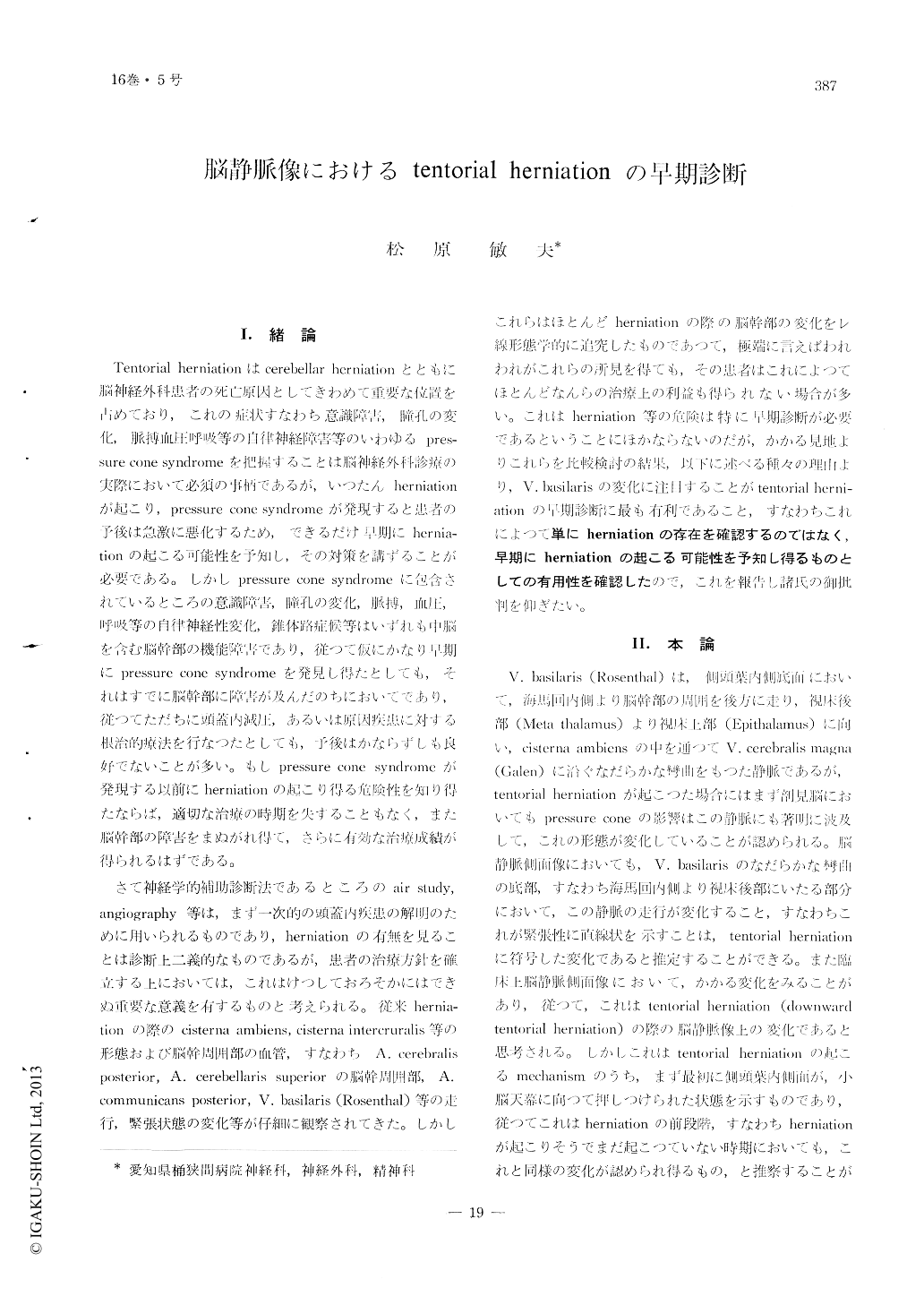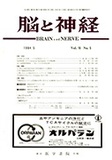Japanese
English
- 有料閲覧
- Abstract 文献概要
- 1ページ目 Look Inside
I.緒論
Tentorial herniationはcerebellar herniationとともに脳神経外科患者の死亡原因としてきわめて重要な位置を占めており,これの症状すなわち意識障害,瞳孔の変化,脈搏血圧呼吸等の自律神経障害等のいわゆるpres—sure cone syndromeを把握することは脳神経外科診療の実際において必須の事柄であるが,いつたんherniationが起こり,pressure cone syndromeが発現すると患者の予後は急激に悪化するため,できるだけ早期にhernia—tionの起こる可能性を予知し,その対策を講ずることが必要である。しかしpressure cone syndromeに包含されているところの意識障害,瞳孔の変化,脈搏,血圧,呼吸等の自律神経性変化,錐体路症候等はいずれも中脳を含む脳幹部の機能障害であり,従つて仮にかなり早期にpressure cone syndromeを発見し得たとしても,それはすでに脳幹部に障害が及んだのちにおいてであり,従つてただちに頭蓋内減圧,あるいは原因疾患に対する根治的療法を行なつたとしても,予後はかならずしも良好でないことが多い。もしpressure cone syndromeが発現する以前にherniationの起こり得る危険性を知り得たならば,適切な治療の時期を失することもなく,また脳幹部の障害をまぬがれ得て,さらに有効な治療成績が得られるはずである。
さて神経学的補助診断法であるところのair study,angiography等は,まず一次的の頭蓋内疾患の解明のために用いられるものであり,herniationの有無を見ることは診断上二義的なものであるが,患者の治療方針を確立する上においては,これはけつしておろそかにはできぬ重要な意義を有するものと考えられる。従来hernia—tionの際のcisterna ambiens,cisterna intercruralis等の形態および脳幹周囲部の血管,すなわちA. cerebralisposterior, A. cerebellaris superiorの脳幹周囲部,A.communicans posterior, V. basilaris (Rosenthal)等の走行,緊張状態の変化等が仔細に観察されてきた。しかしこれらはほとんどherniationの際の脳幹部の変化をレ線形態学的に追究したものであつて,極端に言えばわれわれがこれらの所見を得ても,その患者はこれによつてほとんどなんらの治療上の利益も得られない場合が多い。これはherniation等の危険は特に早期診断が必要であるということにほかならないのだが,かかる見地よりこれらを比較検討の結果,以下に述べる種々の理由より,V. basilarisの変化に注目することがtentorial herni—ationの早期診断に最も有利であること,すなわちこれによつて単にherniationの存在を確認するのではなく,早期にhemiationの起こる可能性を予知し得るものとしての有用性を確認したので,これを報告し諸氏の御批判を仰ぎたい。
Tentorial herniation plays one of the most im-portant roles in the fate of neurosurgical patients, so the detection of neurological pressure cone syn-dromes is essential in the clinical practice. However, when the herniation has once developed, prognosis of the patient is becoming often and suddenly worse, it is necessary to make an early diagnosis against the tentorial herniation to have a satisfied treatment. It has been pointed out that the morphological changes of cisterna ambiens (in air study) and some blood vessels surrounding the brain stem (in angiography) call demonstrate the presence of the herniation. The author had some comparisons among those neurorad-iological changes of tentorial herniation and had taken special considerations on the changes of the basilar vein of Rosenthal in accounts of early diagnosis of the herniation.
The basilar vein runs on the lower surface of temporal lobe surrounding the brain stem, and gently ascends in the cisterna ambiens posteriorly to the thalamus and flows into the great cerebral vein of Galen. In conclusion, it was find out that the stretch-ing in the lower base of this basilar vein in the lateral cerebral phlebogram might be a valuable find-ing for the early diagnosis of downward tentorial herniation. An emphasize should be put on that this finding could be observed before the clinical mani-festation of pressure cone syndromes.

Copyright © 1964, Igaku-Shoin Ltd. All rights reserved.


